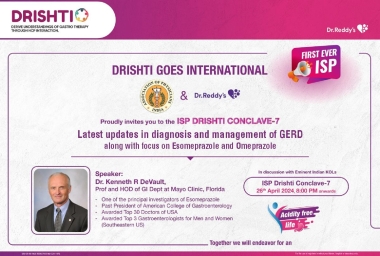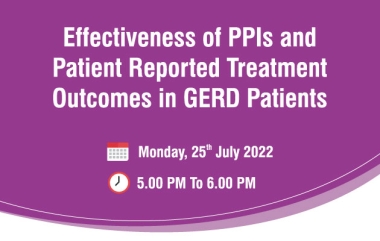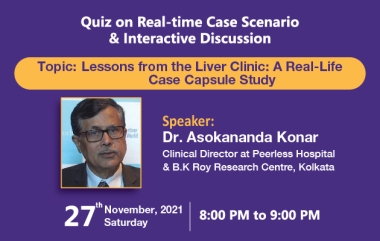test
test
test
test
test
test
test
test
test
test
Webinars
Courses
Medshorts

Efficacy of VOS in showing reduced risk of recurrent Clostridioides difficile infection
According to a recent study, VOS, an oral microbiota therapeutic, reduced the risk of recurrent Clostridioides difficile infection (rCDI) at week 8. This study was published in the journal, Clinical infectious diseases.
The ECOSPOR III trial was a phase 3, double-blind, placebo-controlled, randomized trial that included 182 adult participants with rCDI who were randomized to receive 4 capsules daily for 3 days of VOS or placebo following standard-of-care antibiotics. This post hoc analysis assessed the rate of rCDI through week 8, including Charlson comorbidity index (CCI) score category, baseline creatinine clearance, exposure to non-CDI-targeted antibiotics after dosing, number of CDI episodes, and acid-suppressing medication use at baseline.
At the end of 8 weeks, comorbidities were common with a mean overall baseline age-adjusted CCI score of 4.1. However, the VOS-treated participants had a lower relative risk of recurrence across all subgroups analyzed. Hence, it can be concluded that VOS may reduce the risk of rCDI regardless of baseline characteristics, concomitant medications, or comorbidities.

Efficacy of VOS in showing reduced risk of recurrent Clostridioides difficile infection
According to a recent study, VOS, an oral microbiota therapeutic, reduced the risk of recurrent Clostridioides difficile infection (rCDI) at week 8. This study was published in the journal, Clinical infectious diseases.
The ECOSPOR III trial was a phase 3, double-blind, placebo-controlled, randomized trial that included 182 adult participants with rCDI who were randomized to receive 4 capsules daily for 3 days of VOS or placebo following standard-of-care antibiotics. This post hoc analysis assessed the rate of rCDI through week 8, including Charlson comorbidity index (CCI) score category, baseline creatinine clearance, exposure to non-CDI-targeted antibiotics after dosing, number of CDI episodes, and acid-suppressing medication use at baseline.
At the end of 8 weeks, comorbidities were common with a mean overall baseline age-adjusted CCI score of 4.1. However, the VOS-treated participants had a lower relative risk of recurrence across all subgroups analyzed. Hence, it can be concluded that VOS may reduce the risk of rCDI regardless of baseline characteristics, concomitant medications, or comorbidities.


Efficacy of VOS in showing reduced risk of recurrent Clostridioides difficile infection
According to a recent study, VOS, an oral microbiota therapeutic, reduced the risk of recurrent Clostridioides difficile infection (rCDI) at week 8. This study was published in the journal, Clinical infectious diseases.
The ECOSPOR III trial was a phase 3, double-blind, placebo-controlled, randomized trial that included 182 adult participants with rCDI who were randomized to receive 4 capsules daily for 3 days of VOS or placebo following standard-of-care antibiotics. This post hoc analysis assessed the rate of rCDI through week 8, including Charlson comorbidity index (CCI) score category, baseline creatinine clearance, exposure to non-CDI-targeted antibiotics after dosing, number of CDI episodes, and acid-suppressing medication use at baseline.
At the end of 8 weeks, comorbidities were common with a mean overall baseline age-adjusted CCI score of 4.1. However, the VOS-treated participants had a lower relative risk of recurrence across all subgroups analyzed. Hence, it can be concluded that VOS may reduce the risk of rCDI regardless of baseline characteristics, concomitant medications, or comorbidities.

Greater hemostasis and lower rebleeding rates with TC-325 hemostatic powder; treatment for Gastrointestinal Tumor
A recent study found that TC-325 hemostasis powder achieved greater immediate hemostasis rates and lower 30-day rebleeding rates when compared to contemporary standard endoscopic treatment (SET). This study’s results were published in the journal, Gastroenterology.
This study was a multicenter, randomized controlled trial that was patient-and outcome assessor-blinded. Patients who presented with active bleeding from an upper or lower GI lesion were randomly allocated to receive either TC-325 alone or standard endoscopic treatment (SET). A total of 106 patients made it in the study population (55 in TC-325, 51 in SET), with 1 exclusion in TC- 325 and 5 in SET. Primary outcome of the study was 30-day rebleeding while the secondary objectives were immediate hemostasis and other clinically relevant endpoints.
It was observed that the 30-day rebleeding was significantly lower in the TC-325. The immediate hemostasis rates were 100% and 68.6% in the TC-325 group and SET group, respectively. The other secondary outcomes were not different between the two groups. From these results, it may be concluded that when compared to the contemporary SET, TC-325 hemostatic powder results in greater immediate hemostasis rates followed by lower 30-day rebleeding rates.

Greater hemostasis and lower rebleeding rates with TC-325 hemostatic powder; treatment for Gastrointestinal Tumor
A recent study found that TC-325 hemostasis powder achieved greater immediate hemostasis rates and lower 30-day rebleeding rates when compared to contemporary standard endoscopic treatment (SET). This study’s results were published in the journal, Gastroenterology.
This study was a multicenter, randomized controlled trial that was patient-and outcome assessor-blinded. Patients who presented with active bleeding from an upper or lower GI lesion were randomly allocated to receive either TC-325 alone or standard endoscopic treatment (SET). A total of 106 patients made it in the study population (55 in TC-325, 51 in SET), with 1 exclusion in TC- 325 and 5 in SET. Primary outcome of the study was 30-day rebleeding while the secondary objectives were immediate hemostasis and other clinically relevant endpoints.
It was observed that the 30-day rebleeding was significantly lower in the TC-325. The immediate hemostasis rates were 100% and 68.6% in the TC-325 group and SET group, respectively. The other secondary outcomes were not different between the two groups. From these results, it may be concluded that when compared to the contemporary SET, TC-325 hemostatic powder results in greater immediate hemostasis rates followed by lower 30-day rebleeding rates.


Greater hemostasis and lower rebleeding rates with TC-325 hemostatic powder; treatment for Gastrointestinal Tumor
A recent study found that TC-325 hemostasis powder achieved greater immediate hemostasis rates and lower 30-day rebleeding rates when compared to contemporary standard endoscopic treatment (SET). This study’s results were published in the journal, Gastroenterology.
This study was a multicenter, randomized controlled trial that was patient-and outcome assessor-blinded. Patients who presented with active bleeding from an upper or lower GI lesion were randomly allocated to receive either TC-325 alone or standard endoscopic treatment (SET). A total of 106 patients made it in the study population (55 in TC-325, 51 in SET), with 1 exclusion in TC- 325 and 5 in SET. Primary outcome of the study was 30-day rebleeding while the secondary objectives were immediate hemostasis and other clinically relevant endpoints.
It was observed that the 30-day rebleeding was significantly lower in the TC-325. The immediate hemostasis rates were 100% and 68.6% in the TC-325 group and SET group, respectively. The other secondary outcomes were not different between the two groups. From these results, it may be concluded that when compared to the contemporary SET, TC-325 hemostatic powder results in greater immediate hemostasis rates followed by lower 30-day rebleeding rates.

Comparison of radiofrequency ablation with hybrid argon plasma coagulation for eradicating Barrett's esophagus
A recent study suggests that hybrid argon plasma coagulation (H-APC) has slightly better outcomes than radiofrequency ablation (RFA) for eradicating Barrett’s esophagus following endoscopic resection. This study was published in the journal, Surgical Endoscopy.
This prospective, randomized trial included 101 patients who were randomly assigned to either H-APC (n=54) or RFA (n=47). For the H-APC technique, 60W was applied while RFA consisted of a 90° focal catheter and a simplified protocol of 12 J/cm2 × 3 or with a Halo 360° balloon and 10 J/cm2/cleaning/10 J/cm2. Eradication rates as well as adverse events were reported. Follow-up examinations were done after 3, 6, 12 and 24 months. The median follow-up period for the short-term was 6.0 months while it was 21 months for long term. Overall, 211 ablations were performed.
It was observed that eradication rates after long-term follow-up were 74.2% and 82.9% in the RFA and H-APC groups. The mean score of post-interventional pain was significantly higher at 4.56/10 and duration of 7.54 days while it was 2.07/10 over 3.59 days in the H-APC group. Stenosis that required intervention was reported in 3.7% of patients in the H-APC arm and 14.9% of those in the RFA arm.
From the above results, it can be concluded that although both ablation techniques give good results with respect to the eradication rates, H-APC group showed slightly better outcome. Even the severity and duration of pain were significantly greater for the RFA group than the H-APC group.

Comparison of radiofrequency ablation with hybrid argon plasma coagulation for eradicating Barrett's esophagus
A recent study suggests that hybrid argon plasma coagulation (H-APC) has slightly better outcomes than radiofrequency ablation (RFA) for eradicating Barrett’s esophagus following endoscopic resection. This study was published in the journal, Surgical Endoscopy.
This prospective, randomized trial included 101 patients who were randomly assigned to either H-APC (n=54) or RFA (n=47). For the H-APC technique, 60W was applied while RFA consisted of a 90° focal catheter and a simplified protocol of 12 J/cm2 × 3 or with a Halo 360° balloon and 10 J/cm2/cleaning/10 J/cm2. Eradication rates as well as adverse events were reported. Follow-up examinations were done after 3, 6, 12 and 24 months. The median follow-up period for the short-term was 6.0 months while it was 21 months for long term. Overall, 211 ablations were performed.
It was observed that eradication rates after long-term follow-up were 74.2% and 82.9% in the RFA and H-APC groups. The mean score of post-interventional pain was significantly higher at 4.56/10 and duration of 7.54 days while it was 2.07/10 over 3.59 days in the H-APC group. Stenosis that required intervention was reported in 3.7% of patients in the H-APC arm and 14.9% of those in the RFA arm.
From the above results, it can be concluded that although both ablation techniques give good results with respect to the eradication rates, H-APC group showed slightly better outcome. Even the severity and duration of pain were significantly greater for the RFA group than the H-APC group.


Comparison of radiofrequency ablation with hybrid argon plasma coagulation for eradicating Barrett's esophagus
A recent study suggests that hybrid argon plasma coagulation (H-APC) has slightly better outcomes than radiofrequency ablation (RFA) for eradicating Barrett’s esophagus following endoscopic resection. This study was published in the journal, Surgical Endoscopy.
This prospective, randomized trial included 101 patients who were randomly assigned to either H-APC (n=54) or RFA (n=47). For the H-APC technique, 60W was applied while RFA consisted of a 90° focal catheter and a simplified protocol of 12 J/cm2 × 3 or with a Halo 360° balloon and 10 J/cm2/cleaning/10 J/cm2. Eradication rates as well as adverse events were reported. Follow-up examinations were done after 3, 6, 12 and 24 months. The median follow-up period for the short-term was 6.0 months while it was 21 months for long term. Overall, 211 ablations were performed.
It was observed that eradication rates after long-term follow-up were 74.2% and 82.9% in the RFA and H-APC groups. The mean score of post-interventional pain was significantly higher at 4.56/10 and duration of 7.54 days while it was 2.07/10 over 3.59 days in the H-APC group. Stenosis that required intervention was reported in 3.7% of patients in the H-APC arm and 14.9% of those in the RFA arm.
From the above results, it can be concluded that although both ablation techniques give good results with respect to the eradication rates, H-APC group showed slightly better outcome. Even the severity and duration of pain were significantly greater for the RFA group than the H-APC group.























